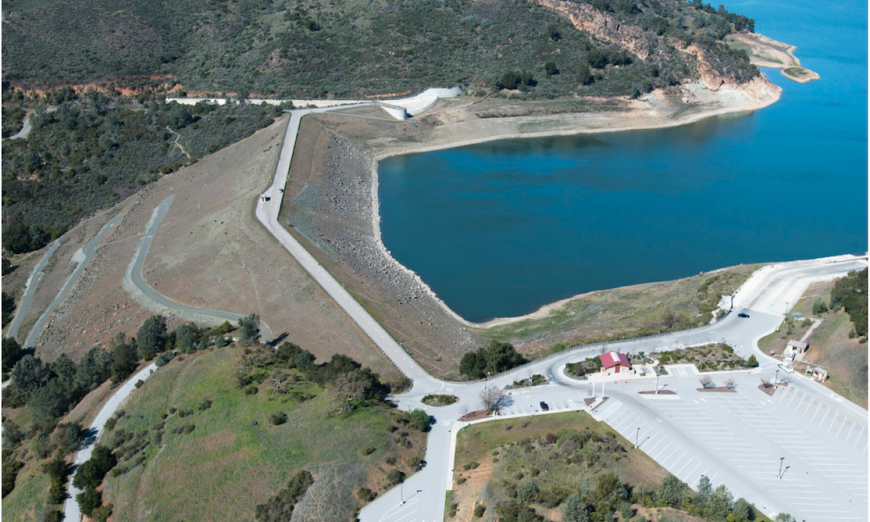Anderson Reservoir, an artificial lake in Morgan Hill that holds 89,278 acre-feet of water is contained by a 240-foot dam built in 1950. Although the dam has never sustained earthquake damage, including from the 6.9 magnitude Loma Prieta quake in 1989, it lacks modern seismic safety features.
A 2009 study concluded the possibility that a 6.6M earthquake with an epicenter right at the dam or a 7.2M one up to a mile away, could cause dam failure due to liquefaction. Since then, the Santa Clara Valley Water District, which owns the dam, has kept the reservoir’s water at a reduced level as a safety precaution.
Another result of the study was the inception of the Anderson Dam Seismic Retrofit Project costing about $550 million to strengthen the dam against a strong earthquake, however a “complicated and time consuming” process including securing a number of permits amidst changing state and federal regulations has delayed the project for over a decade.
Concerns about seismic safety have persisted, and in 2019 Valley Water released a video showing a worst-case scenario in the event that the dam at 100 percent capacity should fail post-earthquake. In that case, it’s feared that a 35-foot wall of water would torrent through Morgan Hill, dropping down to a still deadly 8 feet, inundating San Jose before emptying into the Bay. The City of Santa Clara and other areas would also be flooded. In 2017, during a record rainy season, the Oroville Dam in Butte County sustained extensive spillway damage and caused a mandatory evacuation of the area. That same year, heavy rains caused devastating flooding in San Jose leading to evacuations and $100 million in damages.
In the face of continued risk and project delays, Valley Water has kept the reservoir at 58 percent capacity or lower, as mandated by the Federal Energy Regulatory Commission, which has jurisdiction over the dam. The reservoir is currently at about 29 percent capacity.
“We operate the reservoir lower than 58 percent to account for winter storms,” explained Nina Hawk, Valley Water’s COO. “During the dry months we keep it at 58 percent. This year it’s lower because it’s been drier than average.”
On Oct. 31 Valley Water submitted a re-evaluation of existing risk reduction measures for the Anderson Dam Seismic Retrofit Project to David Capka, FERC’s Dam Safety and Inspections Director. Capka responded questioning Valley Water’s intention to continue with current reservoir operations and required a plan “for the implementation of interim risk reduction measures involving lowering of the reservoir to decrease the risk of downstream consequences in the event of an earthquake and/or flood event between now and the time the Seismic Retrofit Project is scheduled to begin.”
In a response letter, Valley Water’s Dam Safety Deputy Operating Officer, Chris Hakes outlined several concerns about lowering water levels further, including increased risks of damage to an intake structure, wildlife habitat loss and water supply impacts. FERC ultimately disagreed with Valley Water’s plan to keep current water levels in place and dismissed another proposal to cap the reservoir level at 45 percent, demanding that Valley Water begin draining the reservoir to “deadpool” no later than Oct. 1.
On Feb. 24 Valley Water CEO Norma Camacho released a statement agreeing with FERC that the health and safety of residents is the number one priority, but also reiterated concerns about the structural, environmental and water quality risks posed by emptying the reservoir. Regarding potential water supply issues, Hawk commented that Valley Water has a diverse water portfolio and that with a strong ground water basin, levels are adequate for this year. However, drought conditions in subsequent years could complicate the picture.
“Staff is already exploring other sources of water that will have to come from outside of the county,” stated Camacho. “While residents have done an excellent job of conserving water since 2013, another drought during this timeframe could require everyone to significantly decrease their water use.”
In the meantime, Assembly Member Robert Rivas has introduced legislation, AB 3005, to expedite construction of the Anderson Dam Seismic Retrofit Project by fast tracking the CEQA process and permitting.
According to Matt Keller, Media & Public Relations Supervisor at Valley Water, the seismic retrofit project alone would not require the reservoir to be drained for groundbreaking.
“We’d use the first two years of the project installing a water diversion system to help us drain the reservoir, while also addressing environmental and water supply considerations,” he stated. “The process that FERC is requiring starting by Oct. 1 is not like the planned draining during the ADSRP because we will not have the water diversion system in place and we will have to drain the reservoir with the existing outlet.”
February, usually the wettest month of the year in Northern California, was the driest on record in 2020 with many areas reporting zero precipitation, fueling wildfire and drought concerns. Global climate change has disrupted precipitation patterns vacillating between heavy downpours and unpredictable dry spells.







Anderson Dam was drained completely after the 1984 Morgan Hill earthquake. It was rebuilt to more than meet earthquake safety standards and it filled slowly in 1990. I have photos showing the completely dry bottom of the dam and the partial fill. I don’t know why this information seems to be completely left out of every article I read. I am willing to share the photos. Someone needs to look into this.